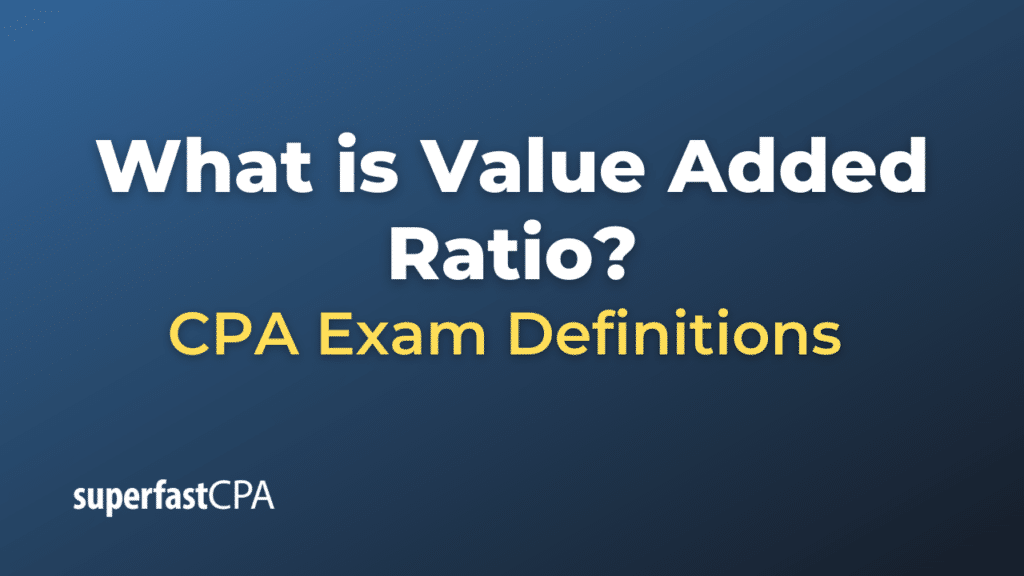Value Added Ratio
The Value Added Ratio is a metric used to evaluate the efficiency of a production process or operation by comparing the value-added activities to the total activities, both value-added and non-value-added. It is generally expressed as a percentage and calculated using the following formula:
Value Added Ratio = Value – Added Time / Total Time × 100
- Value-Added Time: This is the total time spent on activities that directly contribute to the production of the goods or the provision of services. These are the activities for which the customer is willing to pay.
- Total Time: This includes both value-added and non-value-added time spent in the process.
The Value Added Ratio helps to quantify the efficiency of a process by indicating what proportion of the total time is actually spent adding value as seen from the customer’s perspective.
Importance:
- A higher ratio indicates a more efficient process, as more time is spent on value-added activities.
- It provides insights into areas of inefficiency that may require improvement.
- Businesses often use this ratio to target areas for process improvement in methodologies like Lean Manufacturing or Six Sigma.
Example of Value Added Ratio
Let’s use a fictional coffee shop, “Cafe Latte Bliss,” to illustrate the concept of the Value Added Ratio.
Example: Cafe Latte Bliss
In Cafe Latte Bliss, they sell a variety of coffee drinks. The owner, Sarah, wants to improve the efficiency of her coffee-making process, especially for their popular Latte. She decides to calculate the Value Added Ratio to see how much of the total time spent on making a Latte is actually value-added from the customer’s perspective.
Time Breakdown for Making One Latte:
- Order Taking: 1 minute (Value Added)
- Coffee Grinding: 30 seconds (Value Added)
- Espresso Brewing: 1 minute (Value Added)
- Milk Steaming: 1 minute (Value Added)
- Combining and Serving: 30 seconds (Value Added)
- Cleaning the Machine: 1 minute (Non-Value Added)
- Waiting for the Machine to Heat: 30 seconds (Non-Value Added)
Calculating Value Added Time:
The value-added time is the sum of order taking, coffee grinding, espresso brewing, milk steaming, and combining and serving:
1 minute (Order Taking) + 30 seconds (Coffee Grinding) + 1 minute (Espresso Brewing) + 1 minute (Milk Steaming) + 30 seconds (Combining and Serving) = 4 minutes
Calculating Total Time:
The total time includes both value-added and non-value-added activities:
4 minutes (Value-Added Time) + 1 minute (Cleaning) + 30 seconds (Waiting for the Machine) = 5.5 minutes
Calculating Value Added Ratio:
Using the formula:
Value Added Ratio = (Value – Added Time / Total Time) × 100
Value Added Ratio = (45.5) × 100 ≈ 72.73%
Interpretation and Actions:
The Value Added Ratio is approximately 72.73%, meaning that about 73% of the total time spent on making a Latte is value-added from the customer’s perspective. The remaining time (about 27%) is considered non-value-added and presents an opportunity for improvement.
Sarah decides to:
- Implement a routine cleaning schedule for the machine during off-peak hours to minimize non-value-added time during busy hours.
- Upgrade the machine so it retains heat better, reducing the waiting time for the machine to heat up.
By focusing on these areas, Sarah aims to increase the Value Added Ratio, making the process more efficient and improving customer satisfaction.
This example demonstrates how the Value Added Ratio can be used to identify areas of improvement in a business operation, helping to focus on what really matters for creating value for the customer.













